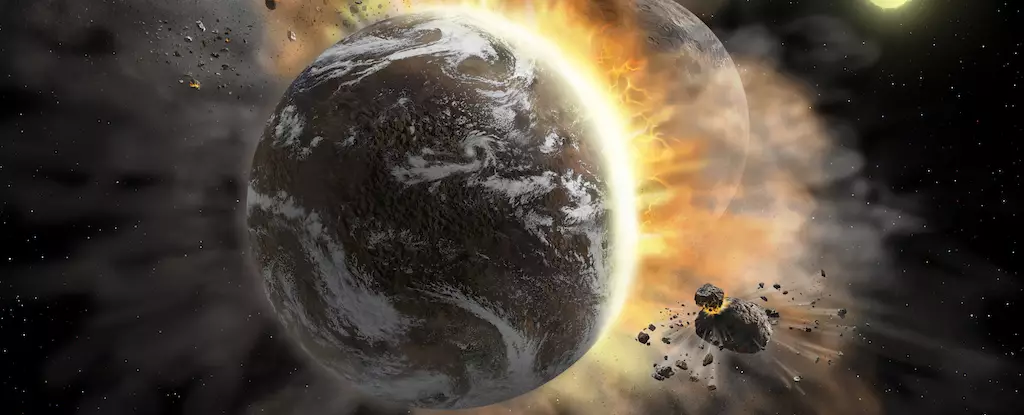To comprehend the tumultuous nature of the early Solar System, we can turn our gaze towards the Moon. Its surface, riddled with craters, tells a tale of violent collisions and chaotic interactions that perfectly encapsulate the primordial phase of planetary formation. The Moon serves as a testament to the hazards faced by celestial bodies in their formative years. In the nascent Solar System, massive objects roamed, colliding in a frenzy, leading to dynamics that may still linger in the evolution of young planets. This foundational understanding of cosmic mayhem invites a parallel exploration into the lives of exoplanets, particularly gas giants beyond our Solar System.
Recent research endeavors have taken a giant leap, simulating cataclysmic confrontations between massive planets. These simulations aim to unlock the mysteries of giant exoplanets’ internal compositions, which, based on current scientific consensus, could house up to 100 Earth masses of solid material within their cores. Such colossal accumulations likely arise from the frequent merging of smaller protoplanetary bodies, each carrying a significant mass. Investigating these dynamics allows us to glean insights into the formation processes that govern planets across the cosmos.
Breaking New Ground with Seismic Investigations
A groundbreaking study, titled “Seismic Oscillations Excited by Giant Impacts in Directly-Imaged Giant Planets,” sheds new light on this topic. Spearheaded by theoretical physicist J.J. Zanazzi from UC Berkeley, the research seeks to determine whether collisions between gas giants can create seismic waves—vibrations traveling through the interior of planets—that persist long enough to be detected. These seismic waves themselves, elusive and faint, become pivotal when considering the observational limitations of the James Webb Space Telescope (JWST).
While JWST cannot detect seismic waves directly, it is equipped to discern subtle changes in light emitted from celestial bodies. The hypothesis is potent: if a giant impact generates substantial seismic oscillations, the resulting photometric variations could fall within the JWST’s detection capabilities. This innovative approach not only highlights the intersection of astronomical observation and theoretical modeling, but it also provides a potential method to probe the internal frameworks of distant gas giants.
Beta Pictoris b: A Case Study
At the center of this research is Beta Pictoris b, a young exoplanet that serves as a prime candidate for observational study. This super-Jupiter, estimated to possess a mass around 13 times that of Jupiter, is barely in its teenage years, only 12 to 20 million years old. Its formation has likely been enriched with heavy metals, fueling intrigue among astronomers seeking to decode the processes behind its development. These findings align with the notion that substantial materials, such as those heavier than iron, are integral to understanding the evolutionary paths of giant exoplanets.
The research team simulated a scenario where a Neptune-mass planet—carrying 17 Earth masses—collides with Beta Pictoris b. The results indicate that such colossal impacts are not merely destructive; they can invigorate the seismic activity within the impacted planet. This interplay of momentum and gravitational forces ignites oscillations that persist over exceedingly long timescales, compatible with the age of the targeted exoplanet. Such seismic oscillations produce luminosity variations detectable by JWST, opening new avenues for examining the changes associated with planetary impacts.
Seismology as a Tool for Grasping Giant Planet Dynamics
The implications of this research extend beyond the detection of seismic waves; they outline a revolutionary method for examining giant planet interiors. By studying how seismic oscillations interplay with photometric changes, scientists can infer properties about a planet’s density and internal structure. This technique offers a direct pathway to understanding intricate planetary architectures that previously eluded our grasp.
Moreover, the potential to detect internal stratifications and gauge planetary migrations provides a fresh perspective on exoplanet studies. The research highlights that impacts aren’t the sole means to excite oscillations; processes such as high eccentricity migration can also produce significant internal vibrations. As more data comes to light through JWST and other observatories, the possibility of detecting tidal forces’ effects in the infrared spectra of these systems adds another layer to the complexity of planetary formation theories.
Exploring seismic oscillations in giant planets not only reveals the consequences of cataclysmic events but also reshapes our understanding of planet formation. As astronomers navigate this uncharted territory, the insights gleaned from studying exoplanets like Beta Pictoris b could illuminate the cosmic journey of celestial bodies, expanding our comprehension of the cosmic tapestry we inhabit.

